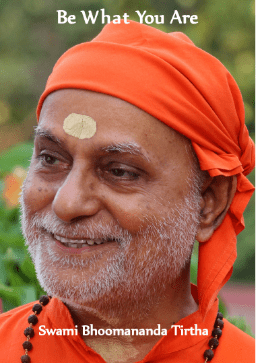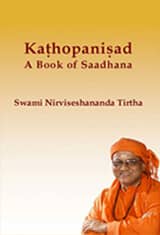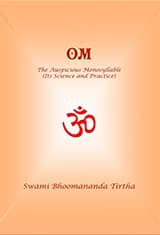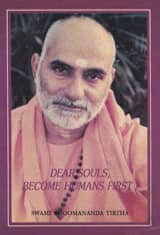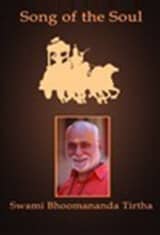Resources
description
Bhagavad Gita
Bhagavad Gita Chapter 5
Ma Gurupriya
-
Bhagavad Gita Chapter 5
Ma Gurupriya
अर्जुन उवाच।
सन्न्यासं कर्मणां कृष्ण पुनर्योगं च शंससि ।
यच्छ्रेय एतयोरेकं तन्मे ब्रूहि सुनिश्चितम् ॥
arjuna uvāca
sannyāsaṃ karmaṇāṃ kṛṣṇa punar-yogaṃ ca śaṃsasi
yacchreya etayor-ekaṃ tan-me brūhi suniścitam – 5.1
Arjuna said: You are extolling, O Krishna, both renunciation of actions and strict adherence to activity. Tell me decisively which of the two bestows supreme felicity (śreyas).
श्रीभगवानुवाच।
सन्न्यास: कर्मयोगश्च नि:श्रेयसकरावुभौ ।
तयोस्तु कर्मसन्न्यासात्कर्मयोगो विशिष्यते ॥
śrī bhagavān-uvāca
sannyāsa: karma-yogaś-ca ni:śreyasakarāv-ubhau
tayos-tu karma-sannyāsāt-karma-yogo viśiṣyate – 5.2
Lord Krishna said: Both renunciation and yoga bring about ni:śreyas (supreme felicity). But, of the two, Karma-yoga excels karma-relinquishment.
ज्ञेय: स नित्यसन्न्यासी यो न द्वेष्टि न काङ्क्षति ।
निर्द्वन्द्वो हि महाबाहो सुखं बन्धात्प्रमुच्यते ॥
jñeya: sa nitya-sannyāsī yo na dveṣṭi na kāṅkṣati
nirdvandvo hi mahābāho sukhaṃ bandhāt-pramucyate – 5.3
He is to be known as a ‘constant renunciate’, who does not desire or hate. O mighty-armed, the one given to nir-dvandvatā (freedom from dual responses) is comfortably freed from bondage.
साङ्ख्ययोगौ पृथग्बाला: प्रवदन्ति न पण्डिता: ।
एकमप्यास्थित: सम्यगुभयोर्विन्दते फलम् ॥
sāṅkhya-yogau pṛthag-bālā: pravadanti na paṇḍitā:
ekam-apy-āsthita: samyag-ubhayor-vindate phalam – 5.4
Only those of immature minds hold sāṅkhya (exclusive wisdom pursuit) and yoga as different; not the enlightened ones. By taking well to either of these, the result of both can be had.
यत्साङ्ख्यै: प्राप्यते स्थानं तद्योगैरपि गम्यते ।
एकं साङ्ख्यं च योगं च य: पश्यति स पश्यति ॥
yat-sāṅkhyai: prāpyate sthānaṃ tad-yogair-api gamyate
ekaṃ sāṅkhyaṃ ca yogaṃ ca ya: paśyati sa paśyati – 5.5
Whatever abode is reached by Sāṅkhya (yoga), that is attained by Yoga (Karma-yoga) too. He who sees Sāṅkhya path and Yoga path as the same, alone has the right vision.
सन्न्यासस्तु महाबाहो दु:खमाप्तुमयोगत: ।
योगयुक्तो मुनिर्ब्रह्म नचिरेणाधिगच्छति ॥
sannyāsas-tu mahābāho du:kham-āptum-ayogata:
yoga-yukto munir-brahma nacireṇādhigacchati – 5.6
The path of sannyāsa is very difficult to attain without the strength and support of yoga. The saint integrated by yoga-sādhanā, attains Brahman (the supreme Reality) before long.
योगयुक्तो विशुद्धात्मा विजितात्मा जितेन्द्रिय: ।
सर्वभूतात्मभूतात्मा कुर्वन्नपि न लिप्यते ॥
yoga-yukto viśuddhātmā vijitātmā jitendriya:
sarva-bhūtātma-bhūtātmā kurvann-api na lipyate – 5.7
Integrated with Yoga, with heart purified, body, mind and senses under control, seeing his Self as the Self of all, he who does his activity, is not tainted thereby.
नैव किञ्चित्करोमीति युक्तो मन्येत तत्त्ववित् ।
पश्यञ्शृण्वन्स्पृशञ्जिघ्रन्नश्नन्गच्छन्स्वपञ्श्वसन् ॥
Naiva kiñcit-karomīti yukto manyeta tattva-vit
paśyañ-śṛṇvan-spṛśañ-jighrann-aśnan-gacchan-svapañ-śvasan – 5.8
The Knower of Truth, who has achieved ‘yogic integration’, will think ‘I do nothing’ even while seeing and hearing, touching and smelling, eating and moving about, sleeping and breathing, speaking and answering the calls of nature, holding, opening and winking his eyes. He understands that in all these the senses alone interact with the sense-objects (and he at heart does nothing at all).
प्रलपन्विसृजन्गृह्णन्नुन्मिषन्निमिषन्नपि ।
इन्द्रियाणीन्द्रियार्थेषु वर्तन्त इति धारयन् ॥
pralapan-visṛjan-gṛhṇann-unmiṣan-nimiṣann-api
indriyāṇīndriyārtheṣu vartanta iti dhārayan – 5.9
The Knower of Truth, who has achieved ‘yogic integration’, will think ‘I do nothing’ even while seeing and hearing, touching and smelling, eating and moving about, sleeping and breathing, speaking and answering the calls of nature, holding, opening and winking his eyes. He understands that in all these the senses alone interact with the sense-objects (and he at heart does nothing at all).
ब्रह्मण्याधाय कर्माणि सङ्गं त्यक्त्वा करोति य: ।
लिप्यते न स पापेन पद्मपत्रमिवाम्भसा ॥
brahmaṇy-ādhāya karmāṇi saṅgaṃ tyaktvā karoti ya:
lipyate na sa pāpena padma-patram-ivāmbhasā – 5.10
Dedicating all actions to Brahman, the supreme Reality, he who acts, eschewing ‘delusional clinging’, is not tainted by evil, just as the lotus leaf, though growing in water, is untouched by it.
कायेन मनसा बुद्ध्या केवलैरिन्द्रियैरपि ।
योगिन: कर्म कुर्वन्ति सङ्गं त्यक्त्वात्मशुद्धये ॥
kāyena manasā buddhyā kevalair-indriyair-api
yogina: karma kurvanti saṅgaṃ tyaktvātma-śuddhaye – 5.11
Abandoning saṅga, yogis perform actions only with their body, mind, intelligence and senses, to gain self-purification.
युक्त: कर्मफलं त्यक्त्वा शान्तिमाप्नोति नैष्ठिकीम् ।
अयुक्त: कामकारेण फले सक्तो निबध्यते ॥
yukta: karma-phalaṃ tyaktvā śāntim-āpnoti naiṣṭhikīm
ayukta: kāma-kāreṇa phale sakto nibadhyate – 5.12
Leaving the subjective results (favourable-unfavourable reactions) of actions, the integrated yogi attains well-founded lasting quietude. Instigated by passion, the un-integrated, clings delusionally to results and gets bound thereby.
सर्वकर्माणि मनसा सन्न्यस्यास्ते सुखं वशी ।
नवद्वारे पुरे देही नैव कुर्वन्न कारयन् ॥
sarvakarmāṇi manasā sannyasyāste sukhaṃ vaśī
nava-dvāre pure dehī naiva kurvan-na kārayan – 5.13
The self-controlled, having renounced all actions mentally, rests comfortably as the Soul in the nine-gated city, namely the body, virtually neither acting nor causing another to act.
न कर्तृत्वं न कर्माणि लोकस्य सृजति प्रभु: ।
न कर्मफलसंयोगं स्वभावस्तु प्रवर्तते ॥
na kartṛtvaṃ na karmāṇi lokasya sṛjati prabhu:
na karma-phala-saṃyogaṃ svabhāvas-tu pravartate – 5.14
The Lord of the Universe does not forge any sense of doership or enjoin actions on anyone; nor again does He connect one with the results of his actions. What indeed acts and activates is one’s own nature, the qualities each possesses.
नादत्ते कस्यचित्पापं न चैव सुकृतं विभु: ।
अज्ञानेनावृतं ज्ञानं तेन मुह्यन्ति जन्तव: ॥
nādatte kasyacit-pāpaṃ na caiva sukṛtaṃ vibhu:
ajñānenāvṛtaṃ jñānaṃ tena muhyanti jantava: – 5.15
The all-powerful Lord does not receive anyone’s sin or virtue. True knowledge is covered by ignorance, and hence are beings deluded.
ज्ञानेन तु तदज्ञानं येषां नाशितमात्मन: ।
तेषामादित्यवज्ज्ञानं प्रकाशयति तत्परम् ॥
jñānena tu tad-ajñānaṃ yeṣāṃ nāśitam-ātmana:
teṣām-ādityavaj-jñānaṃ prakāśayati tat-param – 5.16
Those whose ignorance is exterminated by the knowledge of the Self, that knowledge, like the sun, clearly reveals to them the supreme Truth.
तद्बुद्धयस्तदात्मानस्तन्निष्ठास्तत्परायणा: ।
गच्छन्त्यपुनरावृत्तिं ज्ञाननिर्धूतकल्मषा: ॥
tad-buddhayas-tad-ātmānas-tan-niṣṭhās-tat-parāyaṇā:
gacchanty-apunarāvṛttiṃ jñāna-nirdhūta-kalmaṣā: – 5.17
Knowing That (the supreme Truth), constantly being identified with That, taking That as the wholesome discipline and pursuit, making That the supreme goal, they attain freedom from rebirth, their impurities and sinfulness being completely washed off by Knowledge.
विद्याविनयसंपन्ने ब्राह्मणे गवि हस्तिनि ।
शुनि चैव श्वपाके च पण्डिता: समदर्शिन: ॥
vidyā-vinaya-sampanne brāhmaṇe gavi hastini
śuni caiva śvapāke ca paṇḍitā: sama-darśina: – 5.18
The enlightened ones look at the Brāhmaṇa endowed with learning and humility, the cow, the elephant, the dog as well as the ‘uncultured’ with equal eye.
इहैव तैर्जित: सर्गो येषां साम्ये स्थितं मन: ।
निर्दोषं हि समं ब्रह्म तस्माद्ब्रह्मणि ते स्थिता: ॥
ihaiva tair-jita: sargo yeṣāṃ sāmye sthitaṃ mana:
nirdoṣaṃ hi samaṃ brahma tasmād-brahmaṇi te sthitā: – 5.19
The entire worldliness stands conquered by those, whose mind is established in equal vision. Brahman is taintless and equal. Therefore, by attaining equality, they become established in Brahman.
न प्रहृष्येत्प्रियं प्राप्य नोद्विजेत्प्राप्य चाप्रियम् ।
स्थिरबुद्धिरसम्मूढो ब्रह्मविद् ब्रह्मणि स्थित: ॥
na prahṛṣyet-priyaṃ prāpya nodvijet-prāpya cāpriyam
sthira-buddhir-asammūḍho brahmavid-brahmaṇi sthita: – 5.20
Delight not unduly on meeting the pleasant, nor be aggrieved by the unpleasant. By being so, with stable intelligence, freed of delusion, knowing Brahman well, abide in Brahman.
बाह्यस्पर्शेष्वसक्तात्मा विन्दत्यात्मनि यत्सुखम् ।
स ब्रह्मयोगयुक्तात्मा सुखमक्षयमश्नुते ॥
bāhya-sparśeṣv-asaktātmā vindaty-ātmani yat-sukham
sa brahma-yoga-yuktātmā sukham-akṣayam-aśnute – 5.21
Whatever happiness one derives inwardly from the Self, by not clinging to and associating with the objects around, the same happiness in interminable measure he gets on identifying with Brahman (and gaining the resulting expanse).
ये हि संस्पर्शजा भोगा दु:खयोनय एव ते ।
आद्यन्तवन्त: कौन्तेय न तेषु रमते बुध: ॥
ye hi saṃsparśajā bhogā du:kha-yonaya eva te
ādy-antavanta: kaunteya na teṣu ramate budha: – 5.22
Delights born of sense-object contacts are the wombs of misery. They have a beginning and an end. O son of Kunti, the wise one does not rejoice in them.
शक्नोतीहैव य: सोढुं प्राक्शरीरविमोक्षणात् ।
कामक्रोधोद्भवं वेगं स युक्त: स सुखी नर: ॥
śaknotīhaiva ya: soḍhuṃ prāk-śarīra-vimokṣaṇāt
kāma-krodhodbhavaṃ vegaṃ sa yukta: sa sukhī nara: – 5.23
Whoever is able to withstand the urges of passion and anger before his body falls, is indeed the spiritually integrated and happy human.
योऽन्त:सुखोऽन्तरारामस्तथान्तर्ज्योतिरेव य: ।
स योगी ब्रह्मनिर्वाणं ब्रह्मभूतोऽधिगच्छति ॥
yo’nta:-sukho’ntar-ārāmas-tathāntar-jyotir-eva ya:
sa yogī brahma-nirvāṇaṃ brahma-bhūto’dhigacchati – 5.24
The yogi who lives with inner happiness, revels within himself, and is guided by his own inner light. He, becoming Brahman, attains Braahmic redemption.
लभन्ते ब्रह्मनिर्वाणमृषय: क्षीणकल्मषा: ।
छिन्नद्वैधा यतात्मान: सर्वभूतहिते रता: ॥
labhante brahma-nirvāṇam-ṛṣaya: kṣīṇa-kalmaṣā:
chinna-dvaidhā yatātmāna: sarva-bhūta-hite ratā: – 5.25
Sages, whose blemishes are attenuated, doubts are dispelled, who have enough self-control, and who are interested in the welfare of all beings, attain Brahmic freedom.
कामक्रोधवियुक्तानां यतीनां यतचेतसाम् ।
अभितो ब्रह्मनिर्वाणं वर्तते विदितात्मनाम् ॥
kāma-krodha-viyuktānāṃ yatīnāṃ yata-cetasām
abhito brahma-nirvāṇaṃ vartate viditātmanām – 5.26
Those of self-control, whose minds are rid of lust and anger, who have regulated their mind and have realized the Self, for them Brahma-nirvāṇa – the freedom and joy arising from the knowledge of supreme Reality – reigns all around.
स्पर्शान्कृत्वा बहिर्बाह्यांश्चक्षुश्चैवान्तरे भ्रुवो: ।
प्राणापानौ समौ कृत्वा नासाभ्यन्तरचारिणौ ॥
sparśān-kṛtvā bahir-bāhyāṃś-cakṣuścaivāntare bhruvo:
prāṇāpānau samau kṛtvā nāsābhyantara-cāriṇau – 5.27
Keeping away the external sensory contacts, fixing the vision between the eyebrows, making the incoming and outgoing breaths equal within the nostrils, restraining the senses, mind and intelligence, that Sage who with one-pointed devotion to liberation, rises above desire, fear and hatred, is indeed ever free.
यतेन्द्रियमनोबुद्धिर्मुनिर्मोक्षपरायण: ।
विगतेच्छाभयक्रोधो य: सदा मुक्त एव स: ॥
yatendriya-mano-buddhir-munir-mokṣa-parāyaṇa:
vigatecchā-bhaya-krodho ya: sadā mukta eva sa: – 5.28
Keeping away the external sensory contacts, fixing the vision between the eyebrows, making the incoming and outgoing breaths equal within the nostrils, restraining the senses, mind and intelligence, that Sage who with one-pointed devotion to liberation, rises above desire, fear and hatred, is indeed ever free.
भोक्तारं यज्ञतपसां सर्वलोकमहेश्वरम् ।
सुहृदं सर्वभूतानां ज्ञात्वा मां शान्तिमृच्छति ॥
bhoktāraṃ yajña-tapasāṃ sarva-loka-maheśvaram
suhṛdaṃ sarva-bhūtānāṃ jñātvā māṃ śāntim-ṛcchati – 5.29
Knowing Me as the partaker of all yajñas (sacrifices and austerities), equally the supreme Lord of all the worlds, as well as the friend of all beings, one attains peace and quietude.
ओं तत्सदिति श्रीमद्भगवद्गीतासूपनिषत्सु ब्रह्मविद्यायां योगशास्त्रे श्रीकृष्णार्जुनसंवादे कर्मसन्न्यासयोगो नाम पञ्चमोऽध्याय:।
oṃ tat-sad-iti śrīmad-bhagavad-gītāsūpaniṣatsu brahma-vidyāyāṃ yoga-śāstre śrīkṛṣṇārjuna-saṃvāde karma-sannyāsa-yogo nāma pañcamo’dhyāya:
Om – the symbol of Brahman, tat – that singular Reality (Brahman), sat – the ever abiding presence (Brahman).
Thus ends the fifth chapter entitled Karma-sannyāsa Yoga, during the Srikrishna-Arjuna dialogue in Śrīmad Bhagavad Gita, constituting Yoga-śāstra, which falls within Brahmavidya as presented in the Vedic Upanishads.
Bhagavad Gita
Bhagavad Gita Chapter 5
Ma Gurupriya
You Might Be Interested In
Bhagavad Gita Chapter 1...
Bhagavad Gita Chapter 18
Swami Nirviseshananda Tirtha
Bhagavad Gita Chapter 1
Bhagavad Gita Chapter 1
Swami Nirviseshananda Tirtha
Bhagavad Gita Chapter 7
Bhagavad Gita Chapter 7
Ma Gurupriya





